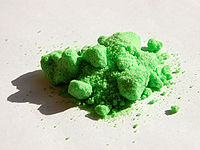
Photo from wikipedia
The reaction of Ph2PCH2OH with PhPCl2 and PCl3 in the presence of Et3N afforded new phosphonite compounds PhP(OCH2PPh2)21 and P(OCH2PPh2)32, respectively. The reaction between 1 and [NiCl2(DME)] in dichloromethane gave… Click to show full abstract
The reaction of Ph2PCH2OH with PhPCl2 and PCl3 in the presence of Et3N afforded new phosphonite compounds PhP(OCH2PPh2)21 and P(OCH2PPh2)32, respectively. The reaction between 1 and [NiCl2(DME)] in dichloromethane gave the five-coordinate complex [NiCl2(1-κ3P,P,P)] 3. Conversely, 1 reacts with [NiCl2(DME)] in the presence of NH4PF6 in dichloromethane to yield the four coordinate ionic complex [NiCl(1-κ3P,P,P)][PF6] 4. The reactions between 1, [NiCl2(DME)] and KPF6 in the presence of RNC (R = Xylyl, tBu and iPr) in dichloromethane yielded the five coordinate monocationic [NiCl(1-κ3P,P,P)(RNC)][PF6] (R = Xylyl) and dicationic [Ni(1-κ3P,P,P)(RNC)2][PF6]2 (R = tBu and iPr) complexes, respectively. The analogous reaction of 2 with [NiCl2(DME)] in the presence of KPF6 gave complex [NiCl(2-κ4P,P,P,P)][PF6], 8. The structures of all complexes were determined by single crystal X-ray diffraction studies and supported by spectroscopic methods. To demonstrate their catalytic application, N-alkylation reactions between primary aryl amines, benzyl and 4-methoxy benzyl alcohols were found to proceed smoothly in the presence of 2.5 mol% of complexes bearing ligand 1 and <0.5 mmol of KOBut in toluene at 140 °C. The C–N coupled products were formed in very good yields. Its substrate scope includes sterically encumbered, heterocyclic amines and aliphatic alcohol.
Journal Title: RSC Advances
Year Published: 2022
Link to full text (if available)
Share on Social Media: Sign Up to like & get
recommendations!